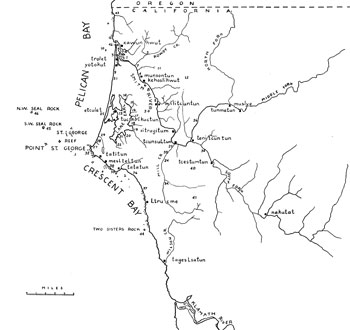Tolowa
Tolowa is the southernmost language within what is usually called Oregon Dene (or Oregon Athabaskan). Tolowa is very closely related to Chetco, its neighbor immediately to the north in Oregon; the two together are regarded as a single (Tolowa-Chetco) language. This is in turn related, if not as closely, to the Rogue River Dene varieties spoken north of Chetco, and more distantly to Upper Umpqua, the northernmost of the Oregon Dene languages. The traditional Tolowa language area is in Del Norte County from Wilson Creek (south of Crescent City) north into Oregon. In pre-contact times, within what is now California there may have been as many as 2,400 speakers of Tolowa itself (Gould 1978). In the 21st century, there are only a few first-language speakers of Tolowa, but there is an active movement to revitalize the language (Golla 2011).
The broader Dene (Athabaskan) language family is spoken across North America with concentrations in western Canada (Dëne Suliné, Sarsi, Slave), Alaska (Ahtna, Gwich’in, Koyukon), the southwest United States (Apache, Navajo), and coastal Oregon and northern California. The other Dene languages of California are Wailaki / Eel River Dene, Hupa, Kato, and Mattole.
Grammatical information
The phonological inventory of Tolowa, and of most other Oregon Dene languages, is distinctive in having merged Proto-Dene coronal affricates and fricatives *ts, *dz, *s, and *z as a single phoneme /s/ (fronted to dental or interdental articulation in some of the languages on the Oregon side of the border). Tolowa stands out from the other Oregon Dene languages in having developed “palatalized and strongly r-colored” [šr] and [tšr’] where other Oregon Dene languages have a less extreme apical retroflex articulation (Golla 2011).
Tolowa prosody requires at least one syllable of each utterance to have high pitch. All utterances with more than one syllable also must have at least one low pitch as well. Bright (1964) gives several (near-) minimal word pairs that differ in accent placement, such as teenéh ‘trail’ vs. tšéeneh ‘base (of tree or rock)’.
Selected archival materials at Berkeley
Selected materials in other archives
Further reading
- Bright, Jane O. 1964. The phonology of Smith River Athapaskan (Tolowa). International Journal of American Linguistics 30:101-107. [PDF - may not be publicly available]
- Collins, James. 1985. Pronouns, markedness, and stem change in Tolowa. International Journal of American Linguistics 51:358-372.
- Collins, James. 1989. Nasalization, lengthening, and phonological rhyme in Tolowa. International Journal of American Linguistics 55:326-340. [PDF - may not be publicly available]
Drucker, Philip. 1937. The Tolowa and their southwest Oregon kin. University of California Publications in American Archaeology and Ethnography 36:221-300. [PDF]
Golla, Victor. 2011. California Indian languages. Berkeley: University of California Press.
- Gould, Richard A. 1978. Tolowa. In Robert F. Heizer, ed., Handbook of North American Indians, Vol. 8: California, 128-136. Washington: Smithsonian Institution.
